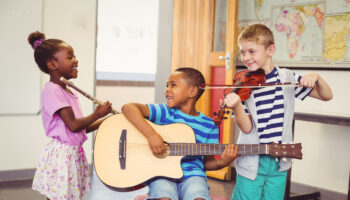Amy Hoffman
I love to sing. I used to be pretty good at it; years of misuse have caused that to change. But no worries! Children still love to hear it. I’ve observed in classrooms where teachers have sounded like pop stars, opera singers, church choir soloists, mildly sing-song, and bullfrogs, and children have responded positively to all of them. There’s just something special to children about a person singing.
When I was in kindergarten my amazing teacher believed in singing to start every day. Miss Lemon taught the class five patriotic songs at the beginning of the school year. The day’s helper was able to choose which song we would all sing. My favorite was “The Star-Spangled Banner” (#3) but I always chose “God Bless America” (#4) because nobody else did. The others were “My Country Tis of Thee” (#1), “America the Beautiful” (#2) and “This Land Is Your Land” (#5). I was recently talking about patriotic songs with friends, and I was able to name (and sing) those five without thinking about it. Miss Lemon’s fondness for singing has embedded those songs into my brain for life.
I learned a lot of academic content through songs. In my earliest years, Sesame Street provided a lot of fun learning about numbers through music. And who can forget “Sing, Sing a Song” by The Carpenters or “Letter B” to the tune of “Let It Be” by the Beatles? Schoolhouse Rock was a special favorite during elementary school. I credit the series with much of my early learning about parts of speech and with the knowledge that George III was King of England during the American Revolution. It’s also why I can recite (sing) the Preamble to the Constitution.
I was a preschool teacher for several years, and I learned that the children in my classroom responded to instructions and retained knowledge when I sang. Therefore, I made up songs all the time and for every purpose:
- Studying the butterfly life cycle or body parts or emotions? I created a song about the steps or topic.
- Time to clean up or get ready to go outside? They never knew how I’d sing the directions, but I always did and they listened and followed the words.
- Everyone was overly loud and things were a little stressful? I sang quietly, either by making up a song or by choosing a classroom favorite, and it helped to make everyone calm.
- A special occasion or just because? I created songs using children’s names and found rhyming words to make it more special. I made sure to point out the rhymes to the children since rhyming is a fun preschool skill.
You can conduct a quick online search and discover that there is much research about why singing and music are important in early childhood (and older) classroom settings.
This post from Harvard has some practical suggestions that you can use to incorporate music to build an inclusive classroom culture. And here is some more information about some benefits of music in your classroom.
So, the next time you are with the children, “Don’t worry if it’s not good enough for anyone else to hear, just sing, sing a song” (The Carpenters). Not only will the children learn from it, but it’s also fun! Take a moment to share in the comments about how you incorporate singing into your classroom.




